Crossbows vs Compound Bows: Which is the Best Choice For You?
The crossbow vs compound bow issue is a debate folks from the archery world never seem to agree on. But we’re going to talk about it. Should you choose the crossbow or go with the less regulated compound bow?
Choosing between the crossbow and the compound bow is not easy. There’s a lot to think about, like specs and safety, and even when you know the kind of bow you want to use, you are going to have questions about the brand or the model. It also depends on what your goals are as an archer and what you want out of the bow.
I’m going to take you through the basics of a crossbow and a compound bow, as well as the specs you should be looking at. At the end of this article, you’ll know exactly what to watch out for when choosing a bow.
Crossbows – How do they work?
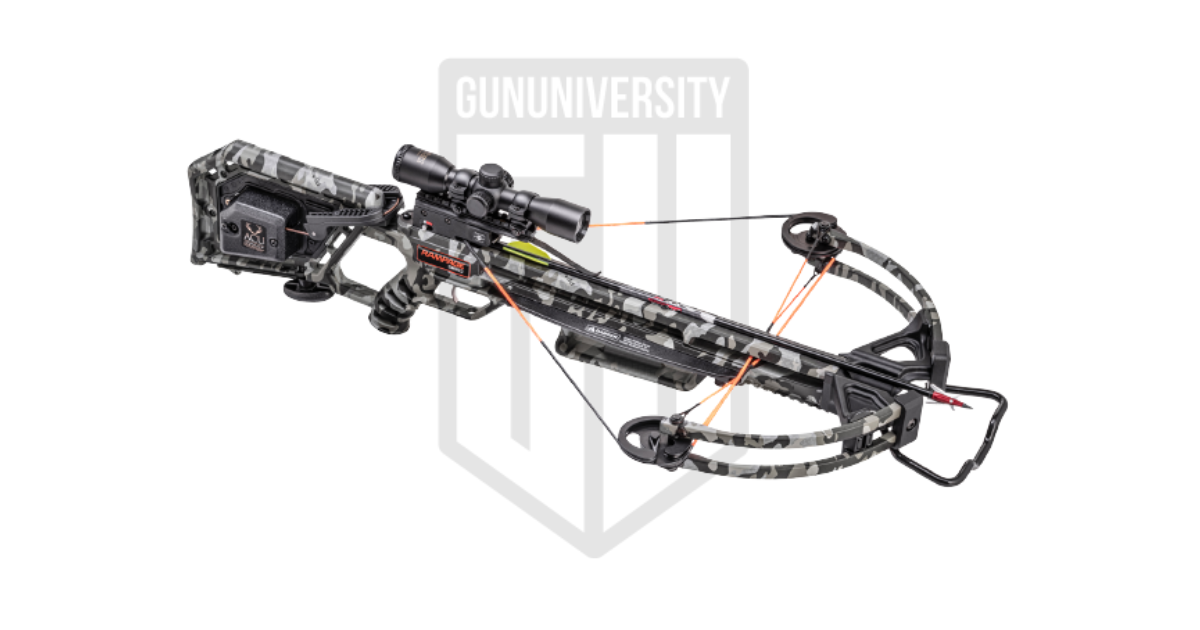
Crossbows are bows placed horizontally on a structure that looks like a gunstock. It works just like a rifle, so if you’re familiar with guns, you’re not going to have any issues operating a crossbow. It has a system that holds the bowstring back for you, and you can pull the trigger to let the bolts fly.
There are three main types of crossbows:
- Recurve Crossbows,similar to traditional crossbows in their design, lightweight and ideal for hunting.
- Compound Crossbows, similar to compound bows, are the modern take on crossbows. They have several moving parts, are very powerful, and can shoot bolts at incredible speeds. I’ll be comparing compound crossbows to compound bows in this blog.
- Pistol Crossbows are mini crossbows you can hold in one hand and have less power than the regular crossbow. You can read more about them here.
There’s a lot to keep in mind when handling a crossbow. For a more detailed look at crossbows, check out this post on our best crossbows.
Pros and Cons of Crossbows
- Beginner friendly, especially for those who have experience handling firearms
- Shorter learning curve
- The ideal choice for veterans and older hunters who want to stay longer in the archery game
- Higher power due to higher draw weights
- Simple transition from rifle
- Ready to fire
- Compact frame
- Loud and noisy
- Are heavy and difficult to maneuver
- Slower to reload
- More regulated than compound bows
- Must be decocked
Compound bows – How do they work?
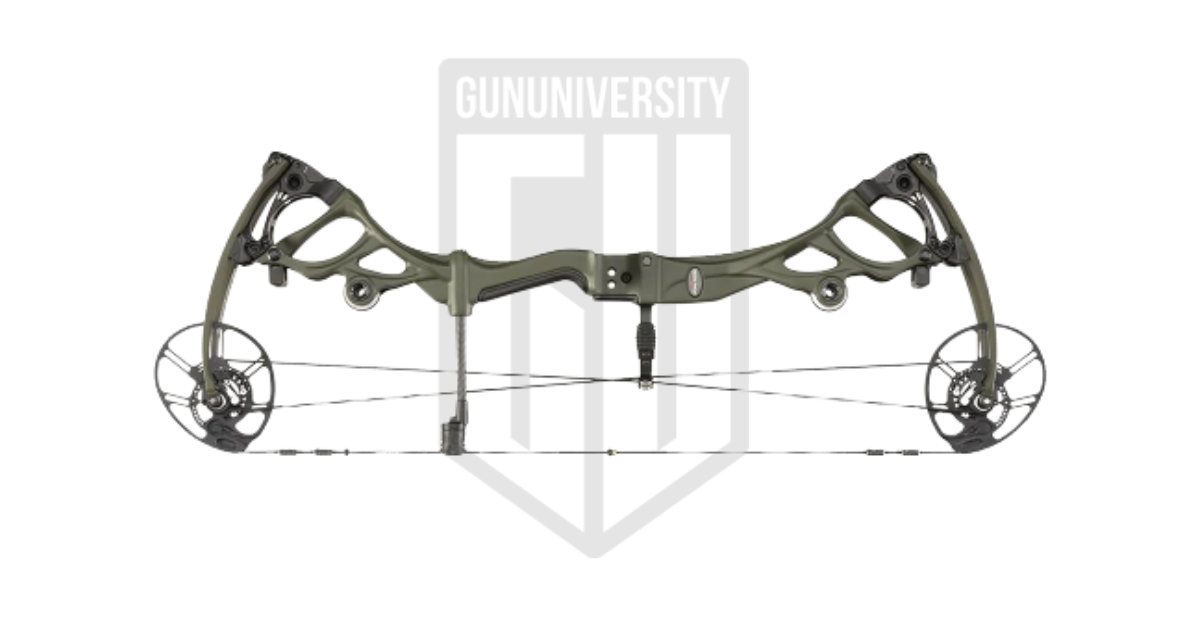
The compound bow uses pulleys to reduce the strain of drawing a bow. What I like about it is that the compound bow has a mechanical advantage that lets you draw bows with higher draw weights than you can do with a longbow. For example, let’s say you can draw a longbow with a -60 lb draw weight. If so, you can easily handle a compound bow with a draw weight 75-80 lbs.
What makes this possible is something we call the ‘let off.’ You may have seen the bows tagged 80% let off or 60% let off in store. For this to make sense, you need to know more about how the compound bow is different from other types of bows. Here’s a quick crash course.
What is let off?
With regular crossbows and longbows, the more you pull back the string, the harder it gets. This is because their complete power comes from the limbs, and pulling them back using a single string takes a lot of effort. With the compound bows, though, they have a system of cables and wheels called the cams and much shorter limbs. When you draw the bow, the cam rolls over and the draw weight drops by a huge margin, so at full draw, you’ll be holding considerably less weight than the peak draw weight. The amount by which the draw weight drops is known as the let off.
Most compound bows I’ve used for hunting have a let off ranging from 70% – 90%, so I’ll only be holding a maximum of 30% of the full draw weight. Of course, getting the draw cycle started at first takes a bit of effort, but after that, it’s pretty much smooth sailing.
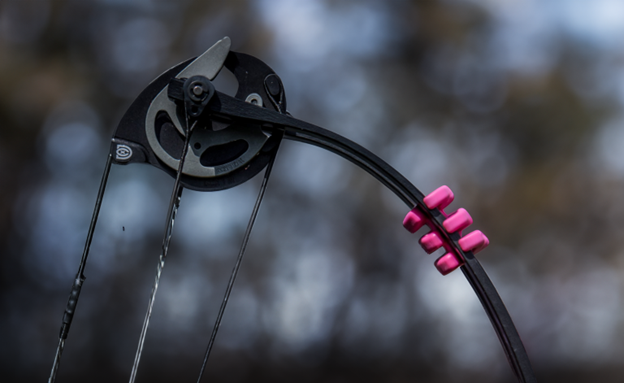
Pros and cons of compound bows
- Quiet and stealthy release that doesn’t scare away prey
- Faster reload
- Provides a mechanical advantage
- Lighter than a crossbow
- No need for a cocking device
- Has a longer learning curve
- May require higher physical strength to draw and hold the bow
- The longer design can make it hard to shoot in thick woods
- Must hold the draw manually
- Limited by the draw weight you can physically handle
Crossbow vs compound bow: How do the specs compare?
If you are new to archery, choosing between the crossbow and the compound bow can be overwhelming. So here, I’ll be comparing the differences in the major specs of the two bow types and see if I can give you a better idea of their features. By the end of this, you should be able to decide what equipment suits you the best.
Range
There are two types of ranges when it comes to bows.
- Overall range – is the maximum distance you can cover with your bow. While both compound bows and crossbows have high overall ranges, they don’t really matter when you hunt because accuracy dips drastically over a long distance.
- Effective range – is your bow’s effective range—the distance at which your bow can confidently deliver a kill shot. This is the range that matters in your hunt.
Usually, compound bows have an effective range of 30-60 yards. This is without the shooting skill of the archer. So, if you are an average shooter, your effective range with the compound would roughly be 30-40 yards.
Crossbows are a little more complicated. While you can take lethal shots with the crossbow at over 100 yards, the ethical range for hunting is 50 yards or less. Ethical ranges are important because otherwise, you can seriously injure but not kill the animal.
Based on range, crossbows are the clear winner since both their overall and effective ranges are a fair bit higher than the compound bows.
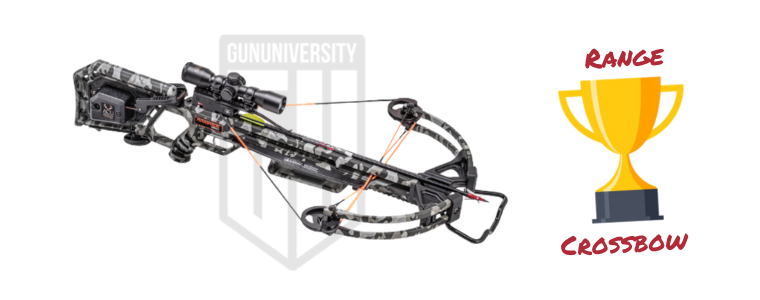
Arrow speed and kinetic energy
To make a humane kill, your arrows need to be fast and carry enough force behind them. This means that the arrow speed and its kinetic energy, which are affected by the draw weight of your bow, are both important for a kill shot.
- We measure arrow speed using Feet Per Second (FPS)
- We measure kinetic energy, or the power behind the shot, in Foot Pounds of Kinetic Energy (FPKE).
The crossbow is far ahead of the compound bow in both these metrics; it can shoot well above 400 FPS, while a compound bow’s maximum speed is 350 FPS. The crossbow also has more draw weight to it, so the bolts you shoot with it carry more kinetic energy than the compound bow as well.
Crossbows are the clear winners in this category as well.

Accuracy
This is a complicated category because, personally, I think there are a lot of good points in favor of both the compound bow and the crossbow.
On one hand, the compound bow is lighter than the crossbow and is easy to aim. But the trade-off is you have to physically hold the draw until you are ready to shoot and this can tire out your arm, affecting your accuracy.
On the other hand, the crossbow is heavier and can be difficult to aim with, but since the scopes you can add to your crossbow are a lot more powerful than compound bow sights, you can dramatically increase your accuracy. Most crossbow scopes have a 4x magnification and their reticles with multiple reference points. All you have to do is to take aim and pull the trigger. Your crossbow also holds the draw for you, so you won’t have to do it manually. Sure, the sights you can add on your compound bow can have multiple aiming points too, but with them, you’ll have to hold the draw until your target is in line with your aiming point before you can shoot.
I’m conflicted here. I can see the advantages and limitations of both, but I would still go with the crossbow because of the ability to add more powerful scopes.
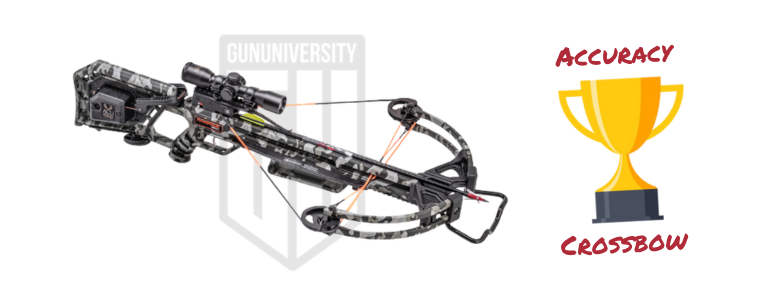
Hunting
Both crossbows and compound are lethal bows and you’ll be well served by either one of them on a hunt. That said, the best weapon for you really depends on what type of hunter you are.
For example, if I am going to be hunting from a tree stand or a ground blind, I would go with a crossbow. In a ground blind especially, a compound bow is not a good choice as I have to draw it back to shoot, and I might not have that much space in a makeshift concealed structure. With the crossbow, all I have to do is shoulder it and pull the trigger.
It would be a totally different scenario if I’m going to spend the hunting season on foot. In that case, the logical choice will be the compound bow, because it is lightweight and won’t tire me out. Either way you will want to select a high quality mechanical broadhead or fixed blade broadhead, but you want to make sure you select a broadhead specific to the type of bow you are shooting.
I’ve got to call it a draw in this category because it’s more about the hunting scenario than the bow.
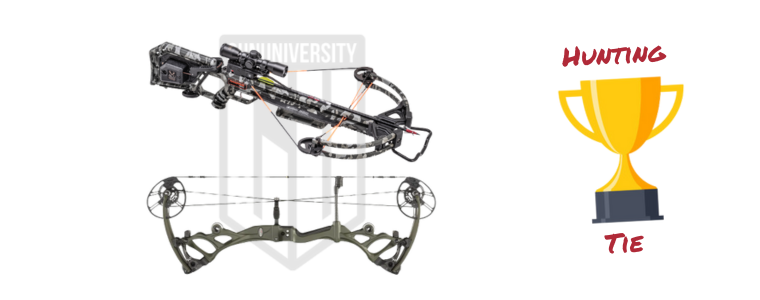
Legality
Compound bows are legal in almost every state for the whole of the hunting season, but it’s a different story with crossbows. They are heavily regulated in several states, and you may have limitations on how far into the hunting season you can use crossbows, who can use them, and the minimum draw weight for the crossbow.
If you are lucky enough to live in the few states that allow both with little restrictions, you can choose whatever you like for the archery hunting season. But for the rest of us, we’ll have to check local regulations around crossbows and proceed according to that.
In this category, the clear winner is the compound bow. They are not heavily regulated and if you want to hunt the whole of the archery season without worrying about legal limitations, then I recommend going with a compound bow.
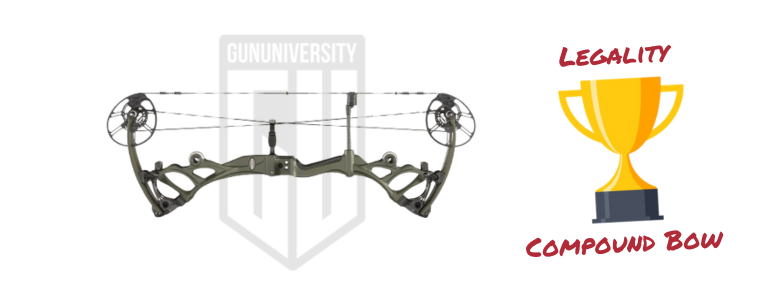
Safety
All the power the crossbow brings to the table also comes with safety concerns around it. It is powerful, but this is one piece of equipment you should never underestimate and always handle with care. There are two main things to keep in mind when handling your crossbow.
- Hand safety – Keeping your hands safe is extremely important when you handle crossbows. I’ve seen experienced hunters lose fingers because their hand was in the path of the bowstring.
- Length and width of the crossbow – You should also be aware of your crossbow’s length and width. A lot of hunters don’t consider the fact that their cocked crossbows are a lot narrower than the uncocked ones; so when firing, you really need some extra space to make sure the bent crossbow limbs can unfurl without any issues.
Compound bows, by design, don’t have many of the issues I’ve talked about with crossbows, but one thing you should definitely do is to get your bow checked by a certified professional every season. Compound crossbows have a bunch of moving parts and there’s a lot of wear and tear only a professional can find, so doing this can prevent any malfunctions when you are off hunting.
Comparing the safety issues between the crossbow and the compound bow, I think the compound bow is definitely the safer option out of the two.

Learning Curve
The learning curve can really be a make or break factor, because most people don’t want a bow that would take forever to master.
- Crossbow learning curve – If you’ve shot a gun before, then you really won’t have much trouble learning the crossbow because they both share similar trigger mechanisms and aiming techniques. Once you’ve got a handle on the basics of a crossbow, you are more or less ready to take it hunting—just be sure to start out small before moving on to larger game.
- Compound bow learning curve – If you’re a beginner, you’ll first have to build up upper body strength and endurance to handle the compound bow. It then takes hours of practice to just master the basics of using a compound bow, and even after, you’re going to need consistent practice if you want to keep your skills polished. You’ll also need to maintain and tune the bow regularly, which can be challenging for beginners as you learn to adjust settings like draw weight and draw length for optimal performance.
While mastering the compound bow can be a rewarding experience and one I highly recommend if you are an archery enthusiast, it can put a damper on your excitement if you just want to take your bow hunting as soon as you can.
Since the crossbow is easier to learn, it’s the winner here.

Portability
Portability depends on your hunting style. If your hunting style involves using a tree stand or staying in one place waiting for your quarry, then your bow being lightweight and easy to carry isn’t going to do much for you. But if you are someone who hunts on your feet all day, then crossbows, which are considerably heavier than compound bows, can really weigh you down and tire you out.
So for that reason, the compound bow wins in this category because it is so lightweight and streamlined. When I am out in the woods and hunting on foot, I go with a compound bow because it’s so much easier to maneuver and light enough that I can carry it around all day without feeling it.
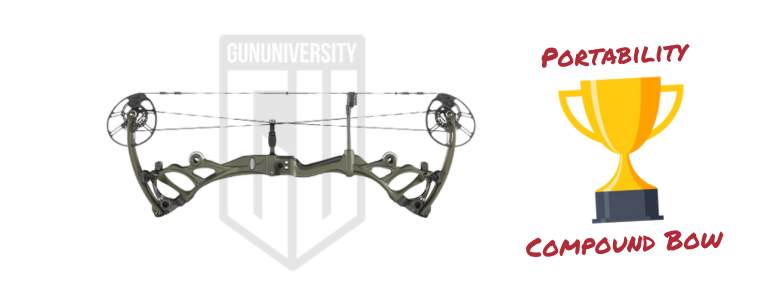
Maintenance
Both the crossbow and the compound bow need maintenance. They both have a lot of moving parts that need to be oiled and maintained. I also suggest taking it to a professional for inspection before every season, this’ll help you avoid the risk of it breaking down in the middle of a hunt.

Noise
With noise, crossbows are incredibly loud while compound bows are quieter and perfect if you are hunting in the woods. The reason you usually get only one shot with a crossbow is because the firing sound scares away all game from the area, and it also takes forever to reload. But with the compound bow, you can line up another shot if you miss the first one because it is so quiet.
You can opt for a silencer to make your crossbow quieter, but it’s never going to be as silent as the compound bow.
In this category, the obvious winner is the compound bow.
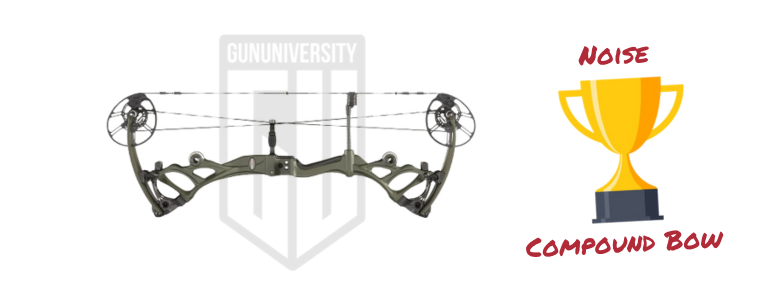
Cost
While high-end crossbows can be very expensive (a full $1,000 more than the most expensive compound bow I could find at the time of writing this article), the lower and middle range crossbows and compound bows cost pretty much the same.
When you are looking at the crossbow prices, I recommend thinking about the crossbow’s maintenance costs as well. You are going to face some extra expenses, like replacing strings, getting specialized tools, and maybe even paying for maintenance services over the course of using your crossbow. So, take a moment to think about your overall cost, including the initial purchase price and ongoing maintenance, to make sure your decision won’t break the bank in the long run.
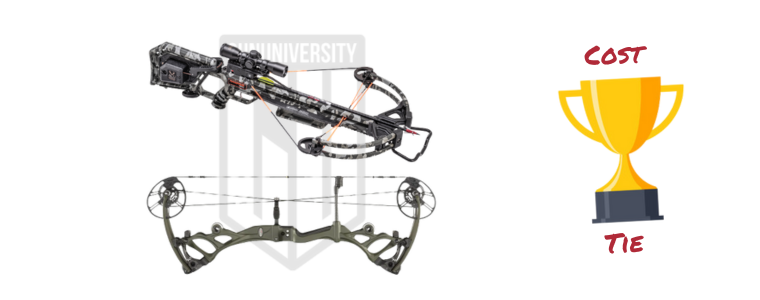
Here’s the deal. Both the crossbow and the compound bow are great archery equipment to hunt with, but the right choice for you will really depend on your preference and situation.
What Should You Choose?
If you ask me straight out which one is better, compound bows or crossbows, I would say there’s no right answer. The choice really depends on what you want, and you’ll have to choose the bow that can help you achieve your goals as a bowhunter.
For example, if you are a hunter who doesn’t really care about archery much, the best choice for you would be the crossbow. The compound bow is a huge time sink, and what’s the point of putting in that much effort if you don’t even like archery? You can do it more quickly and easily with the crossbow. But for archery hobbyists, the compound bow is a good choice.
To make your choice easier, I’ve put together a list of my favorite compound bows and crossbows. As always, while reviews are helpful, the best way to find the right one for you is to try them out yourself before making a purchase.
Gun University’s Picks For Crossbows and Compound Bows
Here are a few of my top choices: some are my old favorites I’ve used for a while and others are newcomers that have proved themselves. They are all good choices, but depending on your needs and preferences, some might be a better fit than the others.
Crossbows Picks
Here are my picks for crossbows. You can read a more detailed article on them here. We also have articles for our top crossbow picks for women and for kids.
Centerpoint CP400
A 200lb draw weight cross bow with Silent Crank cocking system and a stirrup that doubles as a bi-pod.
CenterPoint CP400 Specs
- Weight (lbs) 7.1
- Draw Weight (lbs) 200
- Draw Length (in) 13
- Speed (FPS) 400
- Suggested Bolt Length (in) 20
CenterPoint CP400 Review
The CenterPoint Archery CP400 is one of the most popular crossbows on the market, and I can definitely see why. Its Helicoil technology, compact size, and affordable price made it an instant favorite for me.
Assembling the CP400 is pretty straightforward because it comes mostly assembled; the only thing you’d need to do is to install the scope and the ambidextrous quick-detach quiver, and you are good to go. The CP400 is incredibly accurate, and it has enough speed and power at 400 FPS; I was able to group most of my bolts on the range. The only issue I have with it is that it needs a better trigger–the current one can be a little unreliable because sometimes it can get stuck.
I also really like the 3×32 illuminated scope. It is very impressive because most of the time, I’d have to replace the scope sent alongside the crossbow with my Vortex Crossbow Crossfire 2 2-7 x 32 scope. But with this one, I didn’t really have to do it because it suited my needs just fine.
Overall, it’s an excellent crossbow with great value. You can read my full review of the CP400 here.
CenterPoint CP400 Pros and Cons
- Silent crank with ambidextrous handle
- Anti-dry fire and auto safety
- Great accuracy
- Heavy trigger
Barnett XP 380
The Barnett XP 380 has a lot of power and is very easy to use, making it a sound choice for women who want to take up target shooting or hunting.
Barnett 380 XP Specs
- Weight (lbs) 12
- Draw Weight (lbs) 185
- Draw Length (in) 13.8
- Speed (FPS) 380
- Suggested Bolt Length (in) 20
Barnett 380 XP Review
Barnett has a reputation for high quality yet affordable bows, and the Barnett XP 380 is no exception. This is a crossbow that’ll last years and comes in a ready-to-hunt package with a scope, quiver, and two bolts, so you can get started right away.
One thing I like about the XP 380 is how customizable it is; with its adjustable butt stock and pass through foregrip, you can easily resize it for a better fit and, if you can, get it with the crank cocking device. It lowers the draw weight dramatically, and you’ll have a blast hunting with it. Now, the only problem is the XP 400 can be a little too powerful for small game, but with some practice, you should be able to control its power better.
If you are someone who is getting into archery for the first time, I recommend going with the Barnett XP 380. It is a powerful but versatile crossbow with a shooting speed of 380 FPS and 122 feet-pounds of kinetic energy that’s good enough to take down everything except the toughest game out there.
Barnett 380 XP Pros and Cons
- High performance
- Easy to assemble
- Safety features
- Bowstring is rather weak
- Scope mount is flimsy
Ravin R10X Specs
- Weight (lbs) 6.8
- Draw Weight (lbs) 12
- Draw Length (in) 11
- Speed (FPS) 420
- Suggested Bolt Length (in) 20
Ravin R10X Review
If you are looking for a high end crossbow, there’s nothing better out there than the Ravin R10X. Ravin crossbows always make my lists and for good reason; their workmanship is incredible. It is quite a pricey brand, but in my experience, their bows are always well worth the money because of how well they perform.
The R10X is a work of art; its workmanship and quality are clear when you take it out of the box itself, and it’s also incredibly easy to use as it comes pre-assembled. At 420 FPS, it is very powerful, but the thing that really sold me on it is the accuracy. Even at a 100 yard distance, I could shoot dead bullseyes with every shot at the range. Impressive doesn’t even begin to cover it.
Another good thing is that the low draw weight doesn’t sacrifice any power. At the draw weight of just 12 lbs, I didn’t need a cocking device to load bolts.
The Ravin, as I said earlier, is a very pricey crossbow; at the time of writing this article, it’s almost $2000, and I understand if you don’t want to drop that much on a crossbow. But, if you are looking for a premium model and the cost is not a big factor for you, there’s nothing that beats the Ravin R10X.
Ravin R10X Pros and Cons
- Good build quality
- Lightweight and fairly compact
- Good for medium game
- Expensive
- High draw weight
Compound Bow Selections
These are my picks for compound bows. Some of them were only released very recently, but they’ve quickly become favorites.
PSE Mach 34 Specs
- Weight (lbs) 3.65
- Draw Weight (lbs) 50-80
- Draw Length (in) 29-33
- Speed (FPS) 340
- Suggested Arrow Length (in) 33
PSE Mach 34 Review
Building light bows with a rigid riser is easier said than done, but that’s exactly where the PSE Mach 34 comes in. In a compound bow, the riser is the centerpiece of the bow where all the other parts are attached, and it needs to be firm to withstand the tension from other parts.
Not only is the PSE Mach 34 one of the lightest bows out there at just 3.65 lbs, but it also has a very rigid riser because of PSE’s use of Dead Carbon technology. This makes it so there’s very little thump when you release the arrow.
Another feature I really like about the PSE Mach 34 is the Full Draw Stability. I doubted the Full Draw Stability was anything more than a marketing gimmick. It honestly surprised me when the bow delivered everything it promised. The Mach 34 is unlike any other compound bow I’ve shot before, and I didn’t have to adjust my aim constantly since the bow just locks in at full draw. I’m not the most accurate shot with the compound bow, but this one drastically increased my accuracy.
The bow has a whopping 90% let off, and I felt like I could hold it at full-draw all day without tiring out. In fact, when I took it hunting last season, my strategy was to draw the bow while behind cover and slowly judge the range before shooting my quarry. I didn’t have to shoot quickly, because the hold didn’t strain me at all.
The only issue I have with it is that it doesn’t have a Picatinny rail. It’s not a deal-breaker for me, but since it’s a more common rail and they have them on other PSE models, I think they should have put one here too.
If you are someone who is looking for a light but accurate bow, you can’t go wrong with the PSE Mach 34.
PSE Mach 34 Pros and Cons
- Lightweight
- Great accuracy
- Solid, consistent grip
- Shot has a slight thump
- No Picatinny rail
Elite Era Specs
- Weight (lbs) 3.95
- Draw Weight (lbs) 40-70
- Draw Length (in) 25.5-31
- Speed (FPS) 336
- Suggested Bolt Length (in) 33
Elite Era Review
When I first pulled out the Elite Era from the box, I was finally happy to see a compound bow that actually looked sleek. Compound bows can be clunky, but the Elite Era looked lethal when I first saw it, and after shooting it in the range, the performance matches its looks too.
What I like most about the Elite Era is its insanely low vibration and sleek design. The in-hand feel is so balanced that when I first picked it up, it surprised me to learn it weighed 3.95 lbs because it honestly felt much lighter.
The Era features Elite’s signature dual cage riser, which adds a lot of rigidity to the bow. In combination with Elite’s Simplified Exact Tuning (S.E.T) technology, it gives you incredible accuracy. The S.E.T technology helps you fine-tune your bow and really control how your arrows fly. The Era also has a very smooth draw, and I could shoot at 300 FPS at the range, a decent speed for the compound bow.
The Elite Era is priced at the higher end of the spectrum, at almost $1,700. It’s a good bow that delivers great value for its price, but it definitely is expensive.
Elite Era Pros and Cons
- Low vibration
- Quiet release and smooth flight
- Accuracy
- High-end price
Bowtech Carbon One Specs
- Weight (lbs) 4.5
- Draw Weight (lbs) 50-70
- Draw Length (in) 23.5-30.5
- Speed (FPS) 335
- Suggested Bolt Length (in) 33
Bowtech Carbon One Review
Carbon crossbows are all the rage and when Bowtech released Carbon One, I had my fair share of doubts because of the sheer amount of features; they felt over-the-top. But it managed to change my mind quickly because of how versatile it is.
One of my favorite features is the ability to switch between the Performance and the Comfort mode for this bow. As you might have guessed, the Performance mode helps you shoot faster arrows but with an increased draw weight, and the Comfort mode makes shooting easier while reducing arrow speed. Some of the other stuff I liked about it are the flexible cable guards to protect my hands, and the vibration dampeners that reduce the thump.
The Bowtech Carbon One has a pretty smooth draw. In compound bows, the draw cycle is usually difficult to get rolling, but I could easily fully draw and hold the Carbon One with no issues at all.
The only complaint I have about the Carbon One was the grip; it was a bit slick and thin, but I can easily fix this with some hockey tape to create traction.
Bowtech Carbon One Pros and Cons
- Easy and smooth draw
- Variety of features
- Accuracy
- Grip is slick and thin
- Shot has a slight thump
Conclusion
Both compound bows and crossbows are fantastic archery equipment, and no matter what you pick, you can have a lot of fun hunting with them. If you are lucky enough to live in a state that allows both during the hunting season, you can even alternate between the two. At the end of the day, the most important thing is for you to enjoy your hunts. Happy hunting folks.
FAQs
Crossbow is the clear winner when it comes to overall power and accuracy, but the compound bow is more portable, quiet, and has less legal hassle. You should consider your archery goals, your style of hunting, where you plan to hunt, and even the game you are targeting to decide on what works better.
When comparing the two, crossbows are a better choice when it comes to the shooting range, arrow speed, and power. While this depends on different models and the archer’s skill, crossbows are considerably more powerful on the whole compared to compound bows.
Generally, crossbows have better speed, power, and accuracy than compound bows. They can go well over 400 FPS while the speed of compound bows caps off around 350 FPS. Crossbows also have a longer effective range over 100 yards and are easier to learn than a compound bow.
Crossbows shoot farther and have an effective range of over 100 yards, while compound bows have an effective range of around 30-60 yards for most models.
Compound bows are quiet, portable, lighter, and have faster reload. If you’re off hunting small- and medium-sized game like mule deer and whitetail in the woods, compound bows are a good choice.
Crossbows are easier to learn and draw, and don’t need a lot of strength to handle, as even amateur archers can use one. They also have a higher effective range around 100 yards, and can shoot with more power, speed, and accuracy.
Recent Posts
July 26, 2024
July 26, 2024
July 25, 2024

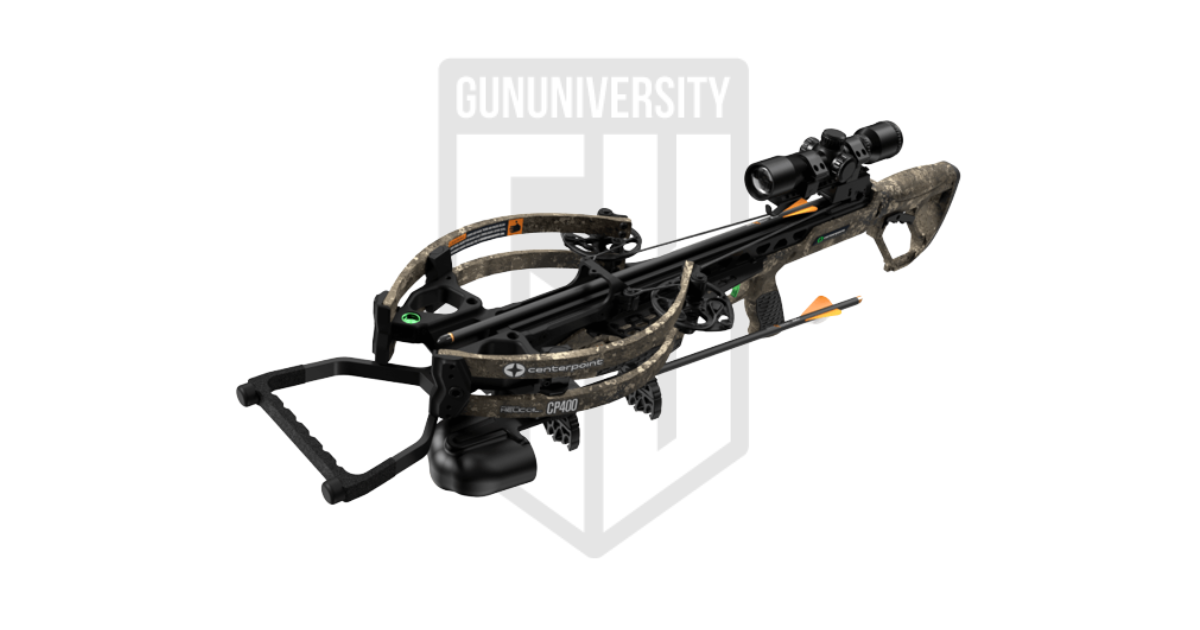
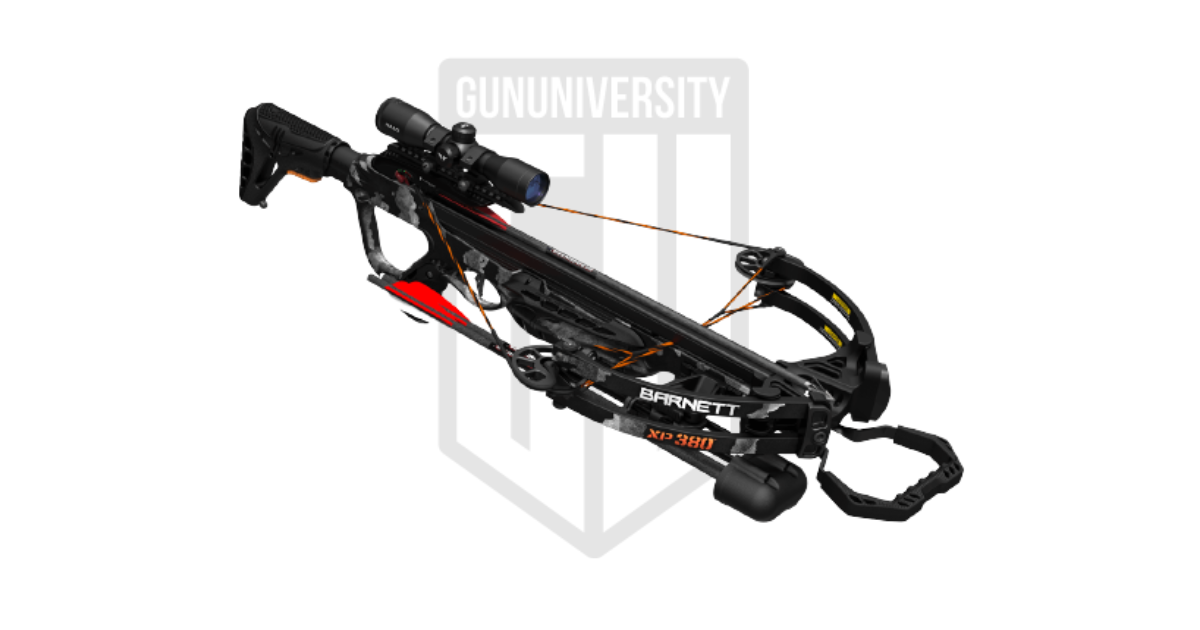

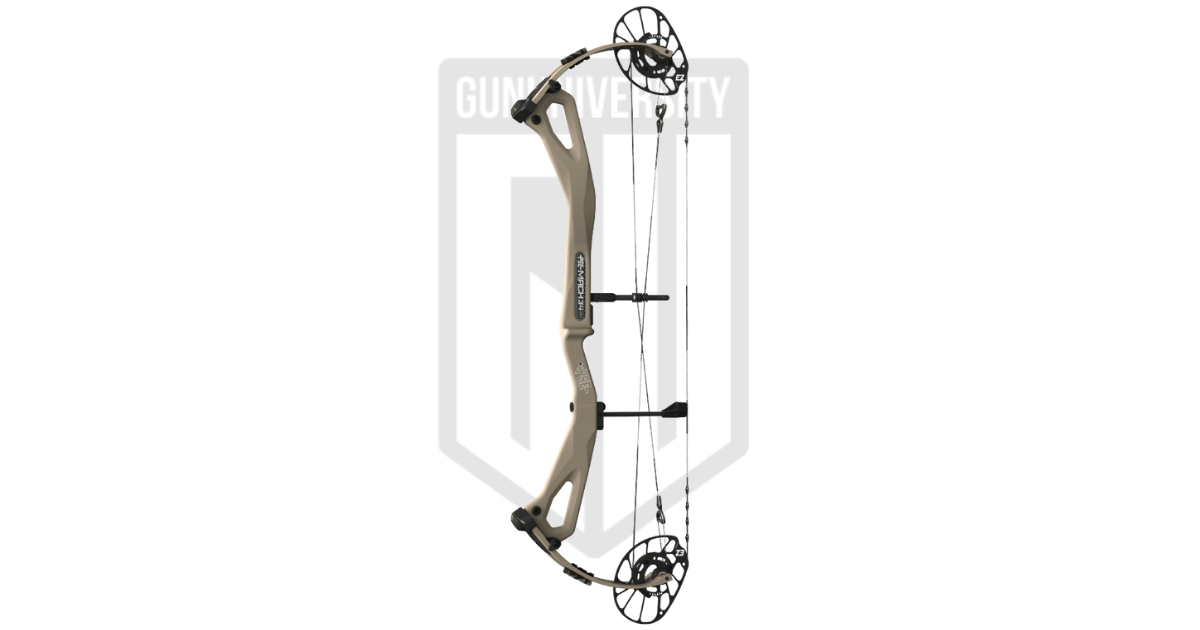
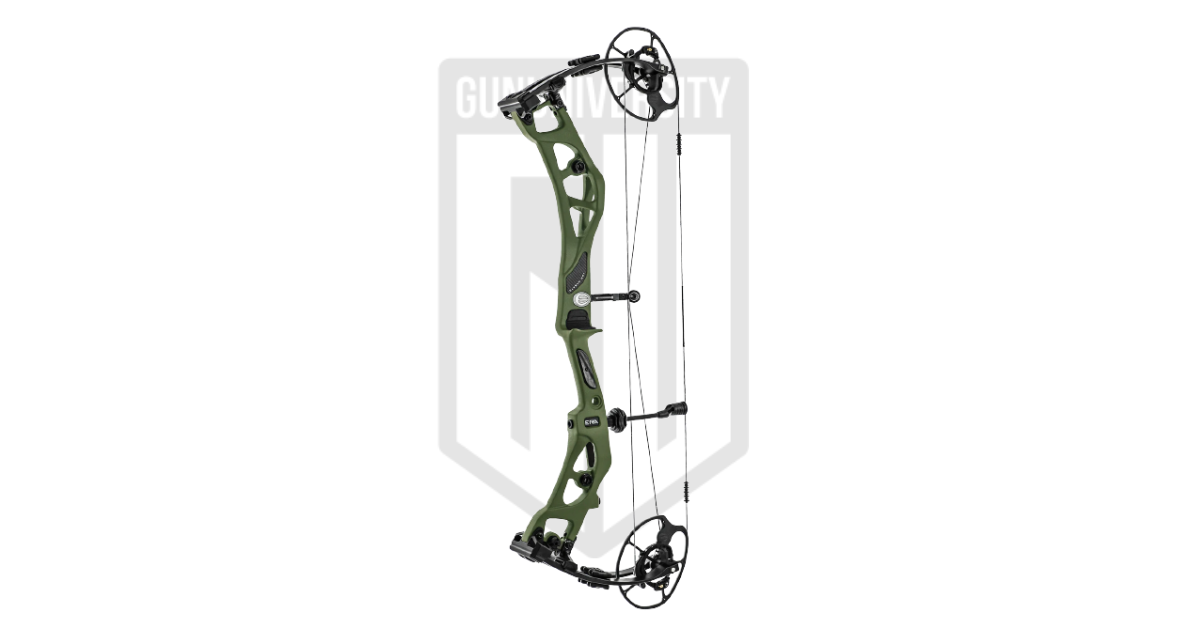

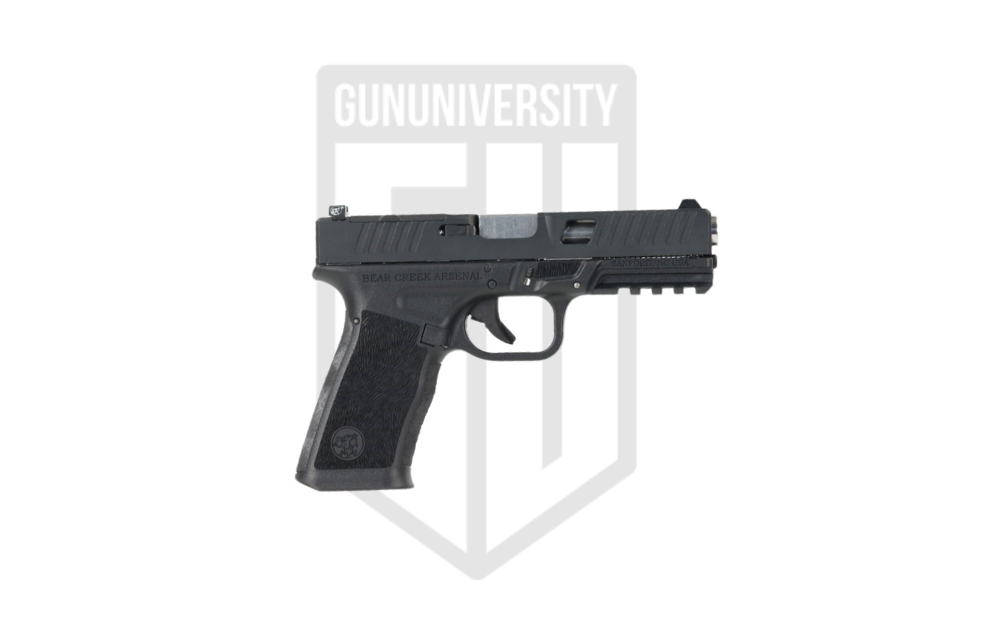
![The Best Shooting Hearing Protection in 2024 [Tested]](https://gununiversity.com/wp-content/uploads/2021/09/best-shooting-hearing-protection.jpg)
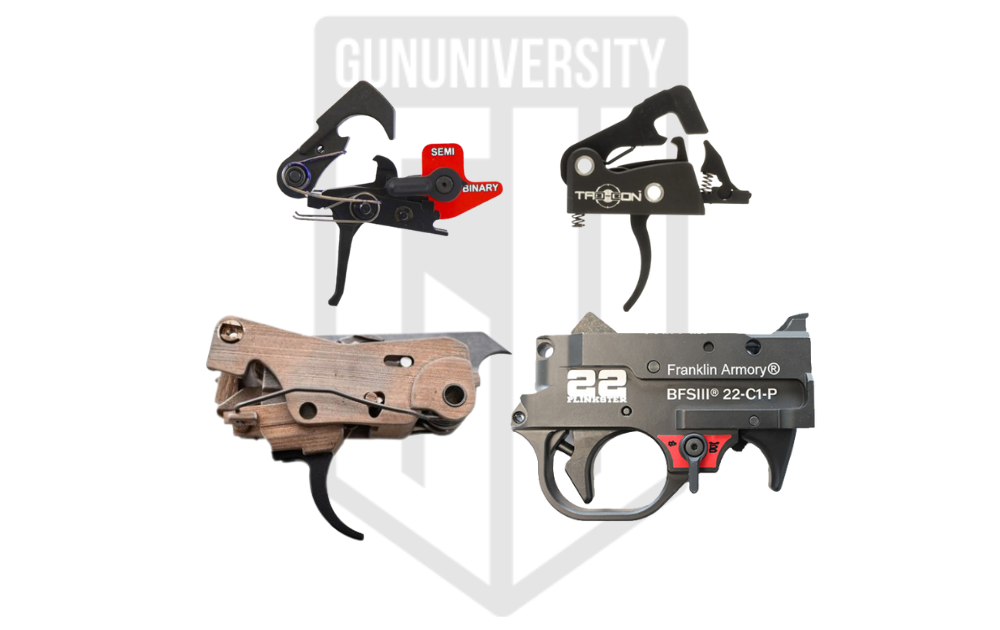
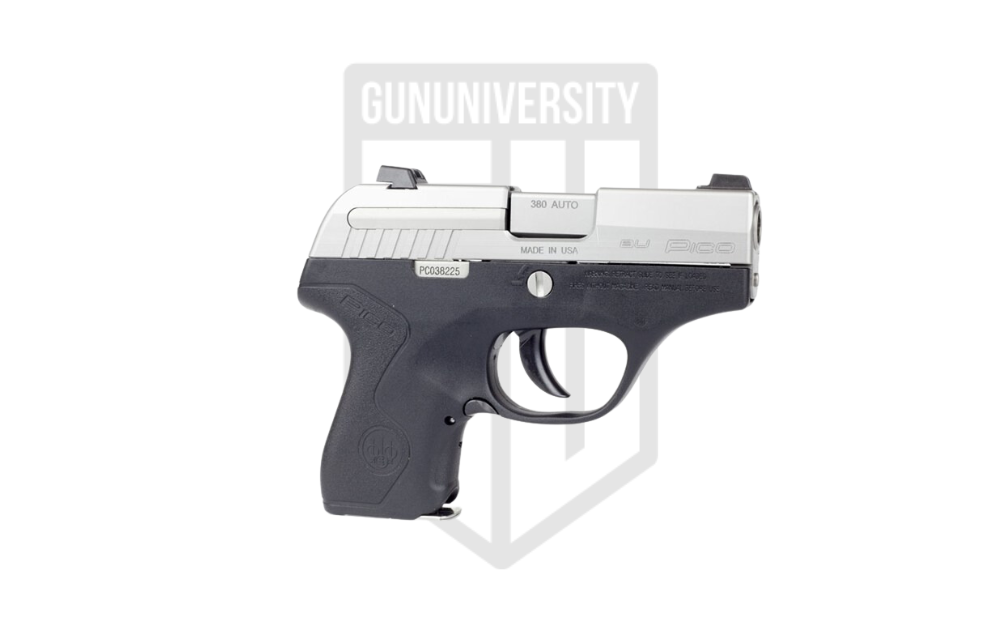
In Poland we can get only compound bows. Because our law banned crossbows. Why? Because they pierce bulletproof vest. But these bows are legal because they are used for sport or hunting smaller animals.
In this comparision you showed us nice equipment and honestly told us about all aspects of them. Full 5 stars from me. Now i need find who sells them in my neightbourhood.